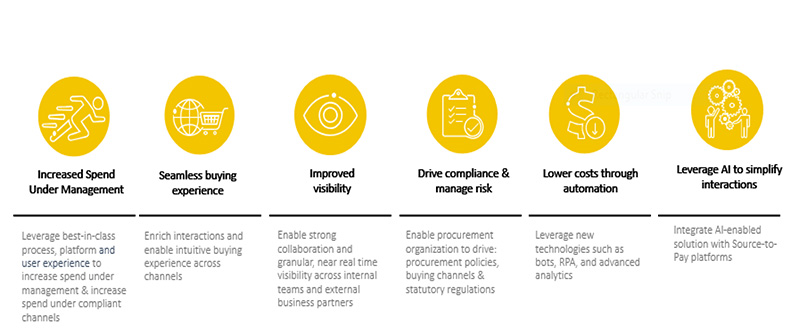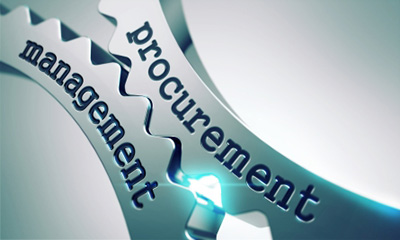Editor’s Note: Kalpesh Swali, is a sourcing and procurement professional with over 20 years' experience. Currently, he is the Associate Vice President-Source to Pay, at Wipro.
We are part of a digital revolution led by demanding customers and powered by a combination of new technologies — from Big Data Analytics to 3D Printing.
This disruption is pushing manufacturers to make drastic changes to their business models. All operational and administrative processes including Procurement are impacted by these innovative digital products and services. In adopting the new normal, procurement is shifting from the traditional approach of enabling cost savings to delivering strategic value to the enterprise.
As organizations continue to invest in intelligent digital processes, Procurement stands at the center of a paradigm shift. The concept of Procurement 4.0 (inspired from ‘Industry 4.0' or ‘the next Industrial Revolution') is part of this shift wherein companies are adopting innovative and smarter ways to digitalize their supply chains and unlock new growth opportunities.
The paradigm shift
Procurement executives today face a two-pronged challenge – drive savings and rethink the value procurement adds to their organizations. They are forced to rethink their engagement model with suppliers in alignment to the business needs and connect the dots to generate value for the end customer. Current effectiveness of business partnering to drive growth stubbornly remains low, however, looking at the future, it will be imperative for Procurement to understand the business and improve its ability to partner with business and drive synergy with suppliers in alignment with business needs. This will enable Procurement to move from a support function to a business value creator.
As procurement metamorphoses into a profit driver, we will see a shift in its priorities, which will call for:
- Leveraging big data analytics for better decision making
- Increasing enterprise value by enabling co-innovation with suppliers
- Creation of digital assistant to provide market intelligence
- Adopting connected platforms to drive change
- Harnessing technologies like Artificial Intelligence, Cognition and Robotic Process Automation
Generating value has become more challenging in the current procurement ecosystem marked by complex and volatile supply chains. The future of Procurement will be marked with innovation-driven value-add.
As Procurement, gets a Digital Makeover, the focus shifts to making the transactional aspect of procurement seamless, amplifying the strategic procurement work, and allowing resource investments to focus on higher value-added activities.
Here are a few approaches and priorities, which will pave the way for embracing new frontiers within Procurement and help, build new value propositions, internally and externally.
Better decision-making
Using analytics to improve decision-making has seen unprecedented maturity over the last decade. The key lies in building mature, actionable predictive models to supplement Procurement's decision-making. Predictive Analytics will provide the requisite deep insights in consumable formats to identify, explain, predict disruptions to supply chain and supply quality, and optimize existing flows.
Across Source to Settle, we see new value propositions. In Sourcing, the new genre of big data analytics enables buyers to have deep insights on spend providing additional capabilities cutting across predictive analytics to scenario analysis.
In Contract Management, ability to track contract meta data and triangulating that information with Sourcing and Purchasing to better manage obligation has been the key pain. This requirement is now being better addressed by cognitive tools sniffing out patterns and outliers, savings millions for companies. Across Purchasing and Settlement, new age technologies not only allow better control of spend but continue to provide deep, near real time insights into buying patterns allowing for development of agile sourcing and fulfillment models.
On the Settlement front, with the spurt in payment options, the ability to provide insights across channels as diverse as traditional cheque to e- wallets to p-cards to bank routing has thrown open a whole new dimension, both in terms of analysis as well as opportunities to save.
Supplier innovation
In the era of knowledge economy, co-innovating with suppliers is essential. The ability to extend innovation capabilities of the enterprise by systematically integrating knowledge and competencies of key suppliers, start-ups and the external “crowd”, will distinguish the leaders from the pack.
As consumers come knocking for a more personalized requirement, time-to-market in trying to address these requirements is the key. Ability to work with supplier eco-system and exchange data across multiple nodes leveraging cognition will enable a 360o interface with the supplier allowing for
- Deep supplier insights though analytics including innovations being carried out by supplier
- Non-linear thought process through rapid prototyping and speed-to-market by running joint innovation councils
- Breaking business challenges into bit-size problem statements and applying logic of crowdsourcing to source solutions in conjunction with customer and supplier
Given co-innovation is the key, it is imperative that Procurement should fulfill its role as an interface manager and catalyst between the external partners and internal functions, such as R&D, product development and production.
From pure play vendor management, Procurement would need to have a seat within business to turn customer requirements into tangible business requirements and partner with suppliers to help them become co-creators of business. These insights will not only help avoid blind spots and identify risks, but also jumpstart an eco-system of co-innovation.
Category expertise
Expertise drives insight and insight drives value in Procurement. Companies dealing in procurement have large number of experienced category specialists. Along with the analytics team and dedicated market intelligence experts, they manage expenditure efficiently. Their subject matter expertise extends to hundreds of discrete categories. However, finding quality market insights while developing category plans is a known challenge and a time-consuming activity.
As we continue to challenge the norm, Cognitive Research Assistant, designed to support the Category Manager in primary and secondary research, is closer to reality. Cognitive bots can reduce the time spend on raw research and analysis for latest category trends by over 50%, making Category Managers future- ready.
The cognitive assistant of the future would be responsible for leveraging insights from spend, provide multimodal relationship map across diverse set of stakeholders including a 360° view of suppliers to the category leader. In a nutshell, the cognitive assistant would start replacing the need of purchasing analyst in near future and expand its presence to Buyer roles by 2025.
Optimized Procure-to-Pay processes
Optimization of Procure-to-Pay has been one of the key agenda for the Chief Procurement Officer (CPO) with focus on driving efficiency, effectiveness and value from the function. At the CPO's disposal are a spectrum of tools and technologies at different levels of maturity to achieve the goal. While these technologies in themselves are not solutions, they definitely are the means to achieving an optimized Procure-to-Pay. Some of these key technologies like sensors, Robotic Process Automation (RPA) and cognition (AI) have seen rapid advancement and investments in the past few years. It is time for CPOs to welcome these bots to their teams across the Procure-to Pay function.
RPA and cognitive computing will help Procure-to-Pay processes move away from a model based on arbitrage to improve the overall quality and delivery speed. A comprehensive range of optimization measures ranging from simplification of processes to the full development of autonomous bots are on the anvil. Some of these measures include transaction-processing bots for updating information across disparate systems and assisting master data activities. Cognitive bots enable categorization of content and data extraction from unstructured data. Further, to enhance CPO team's decision-making, inputs from sensory data coupled with external data-points would be available for inference and action.
Enterprise operations transformation
Companies that aim to make the most of the digital revolution and transform themselves for the future have embarked on a journey of procurement digitization. The digitization journey has different starting points for different companies; however, the imperative transformation is forcing companies to adopt both existing and future technologies to create a disruptive competitive advantage.
Procurement executives need to achieve enterprise operations transformation through the concepts of Simplification – revisiting the process itself; Automation – deploying smart systems across the entire procure-to-pay landscape; Immersive Experience – connected eco-system with end customers, and Intelligence – driving insights all along the Procure-to-pay value chain.
As organizations evolve, not only will companies change what they buy, but also how they buy. During this churn, as a function, Procurement would need to align with the key transformation elements ensuring the function remains relevant (See figure 1).

Towards Procurement 4.0
As companies evolve and fully embrace Procurement 4.0 and as the scope intensifies, new value propositions will be developed and data across value chains and functions will be integrated to meet new business needs.
The Procurement function will play a pivotal role in this journey, shrinking its operational responsibilities by making operative procurement autonomous leveraging digital and robotic technologies in most areas.
With the shifting business focus, the demand on strategic inputs from Procurement will grow, be it ability to enable better decision making by leveraging big data; working and building mutual
value eco-systems with suppliers to drive business needs; welcoming bots to the procurement function to provide category insights; optimizing and digitalizing the procure-to-pay processes, to drive enterprise transformation in alignment to the CPO's strategic markers.
SC
MR


Latest Supply Chain News
- Survey reveals strategies for addressing supply chain, logistics labor shortages
- Israel, Ukraine aid package to increase pressure on aerospace and defense supply chains
- How CPG brands can deliver on supplier diversity promises
- How S&OP provides the answer to in-demand products
- AI, virtual reality is bringing experiential learning into the modern age
- More News
Latest Podcast

 Explore
Explore
Procurement & Sourcing News
- Israel, Ukraine aid package to increase pressure on aerospace and defense supply chains
- How CPG brands can deliver on supplier diversity promises
- How S&OP provides the answer to in-demand products
- There is still work to do to achieve supply chain stability
- Blooming success: The vital role of S&OE in nurturing global supply chains
- How one small part held up shipments of thousands of autos
- More Procurement & Sourcing
Latest Procurement & Sourcing Resources

Subscribe

Supply Chain Management Review delivers the best industry content.

Editors’ Picks





